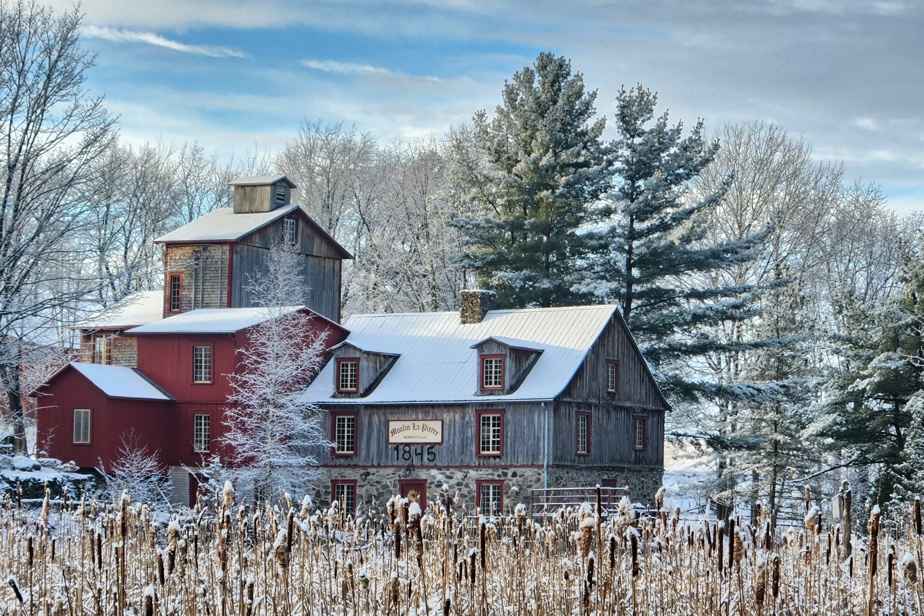In Center-du-Québec, the small municipality of Saint-Norbert-d’Arthabaska is home to one of the last artisanal flour mills still in operation in the province. The building built in 1845 is located on an area of four hectares. The historic property is now for sale.
Many Quebecers learned to make bread during the pandemic. Eric Lamontagne learned to grind grain. A landscaper by training, he bought the La Pierre mill, located in the village of his childhood, in Saint-Norbert-d’Arthabaska near Victoriaville, in 2019.
“He lacked love. It was left in disrepair, he remembers. The previous owner wanted to retire. He had been operating the mill for 20 years. My offer came at the right time. »
Mr. Lamontagne knew nothing about the work of a miller, but he was passionate about renovation. Purchasing the mill was a way of bringing together his passions: landscaping, renovation and history. Because since the construction of the mill 180 years ago, the successions and anecdotes have multiplied. The miller knows all the details, or almost.
Two mills, one sign
Contrary to what the name of the company suggests, the place includes not one, but two mills.
The first is the oldest. Its millstones are located in the original building erected on a stone foundation. It is powered by the flow of the river using turbines. Although it is still functional, it has not been used for eight years.
“It’s impossible to use it all year round because of the freezing of the river,” explains the miller. The grinding of the grain is also not uniform and wetter. »
A second mill powered by electricity was built 40 years ago in the adjacent building. This is the one that Mr. Lamontagne uses every day.
He buys his grains from farms in the region and his production of wheat, buckwheat and spelled flour is certified organic.
“It’s not very complicated to operate a mill,” says the man who describes himself as a resourceful person. There is technical knowledge such as the quality of the grain, the humidity level, but the mechanics and the general principle, for someone with a manual, it is relatively simple. »
It’s simple, but it’s not profitable enough for flour production to be the company’s only income. Luckily, the area has other assets.
Endless possibilities
The Gosselin River emits a familiar sound for Mr. Lamontagne. On the eve of retirement, he remembers coming to fish at the foot of the dam when he was a teenager. After all these decades, the place has retained its charm, but it still has a lot of potential.
On the watercourse, a red covered bridge was built to access the wildest part of the estate. Mr. Lamontagne spent several years clearing the forest to create a park. Members of his family also came to celebrate their wedding there.
Organizing events is one of the many avenues that the owner could have considered to grow his business’s revenue.
I was thinking of converting a small building into an apartment for short-term rental. I also set up a platform with the aim of creating a public market with local producers. There is room for many projects, but that takes time and resources.
Eric Lamontagne, owner
Repairing buildings and working as a miller have occupied Mr. Lamontagne full time in recent years, so that he has not been able to develop other commercial activities.
The single-family house, located next to the mill, has the necessary equipment to produce bread. There is even a shop to welcome visitors. However, the miller never wanted to become a baker like the previous owner.
Instead, he wanted to learn the trade of miller so that the techniques would not be forgotten.
“There are no longer many artisanal mills in Quebec,” he notes. Of the 10 traditional flour mills, there are only a few that operate all year round. »
After returning to the village of his childhood, Eric Lamontagne now wishes to return to his children in Estrie. He dreams of a “real” retirement with his partner. But before leaving, he hopes to pass on his knowledge to future buyers so that the miller does not fall asleep forever.
Consult the property file
The property in brief
Asking price: $1,675,000
Municipal assessment: $366,500
Year of construction: 1845
Description: Small farm comprising an artisanal mill, a house with three bedrooms, a shop with its own entrance, a commercial bakery with all the equipment in the basement, as well as a three and a half room apartment on the ground floor. garden with a private entrance. On the land, there is a double garage, a workshop, a barn, a hydraulic dam and a covered bridge.
Main building area: 160.63 m²
Land area: 38,739.7 m2
Property tax: $3,229.91
School tax: $321.25
